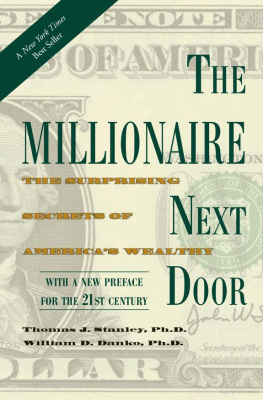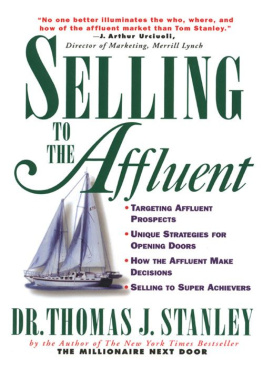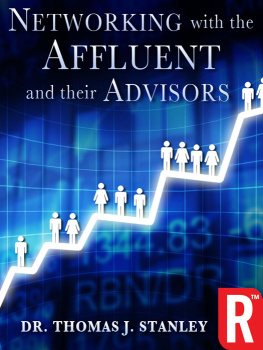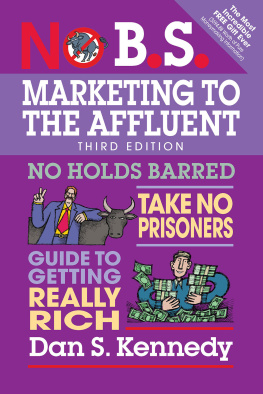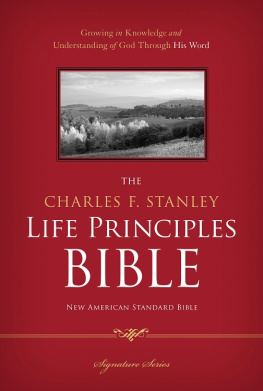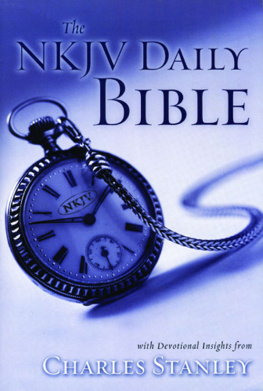Thomas J. Stanley - Marketing to the Affluent
Here you can read online Thomas J. Stanley - Marketing to the Affluent full text of the book (entire story) in english for free. Download pdf and epub, get meaning, cover and reviews about this ebook. year: 2012, publisher: RosettaBooks, genre: Detective and thriller. Description of the work, (preface) as well as reviews are available. Best literature library LitArk.com created for fans of good reading and offers a wide selection of genres:
Romance novel
Science fiction
Adventure
Detective
Science
History
Home and family
Prose
Art
Politics
Computer
Non-fiction
Religion
Business
Children
Humor
Choose a favorite category and find really read worthwhile books. Enjoy immersion in the world of imagination, feel the emotions of the characters or learn something new for yourself, make an fascinating discovery.
- Book:Marketing to the Affluent
- Author:
- Publisher:RosettaBooks
- Genre:
- Year:2012
- Rating:4 / 5
- Favourites:Add to favourites
- Your mark:
- 80
- 1
- 2
- 3
- 4
- 5
Marketing to the Affluent: summary, description and annotation
We offer to read an annotation, description, summary or preface (depends on what the author of the book "Marketing to the Affluent" wrote himself). If you haven't found the necessary information about the book — write in the comments, we will try to find it.
Marketing to the Affluent — read online for free the complete book (whole text) full work
Below is the text of the book, divided by pages. System saving the place of the last page read, allows you to conveniently read the book "Marketing to the Affluent" online for free, without having to search again every time where you left off. Put a bookmark, and you can go to the page where you finished reading at any time.
Font size:
Interval:
Bookmark:
Marketing to the Affluent
Thomas J. Stanley, Ph.D.
Copyright
Marketing to the Affluent
Copyright 1988 by Thomas J. Stanley, Ph. D.
Cover art to the electronic edition copyright 2012 by RosettaBooks, LLC.
All rights reserved. No part of this book may be used or reproduced in any form or by any electronic or mechanical means, including information storage and retrieval systems, without permission in writing from the publisher, except by a reviewer who may quote brief passages in a review.
Electronic edition published 2012 by RosettaBooks, LLC, New York.
ISBN e-Pub edition: 9780795325939
For Janet, Sarah, and Brad
In the mid-1950s, Fieldston was one of the wealthiest neighborhoods within the boundaries of New York City. When I was nine years old, I convinced my older sister to give up our practice of trick-or-treating in our own blue-collar neighborhood. That Halloween, we decided to get into the big time and walk one-half mile across three social classes into Fieldston. The trip took us through the woods into total darkness. The large, exclusive houses were well spaced from each other. We expected a lot of competition, but we encountered no other trick-or-treaters there.
The first house we approached was a very large, Spanish hacienda-type structure situated on several choice acres. No lights were on, but I knocked on the door anyway. Nothing happened, but I kept on knocking. Finally, James Mason, the actor, opened the door. He was startled, and I remember distinctly what he said: No one ever trick-or-treated me, hit on me during Halloween.
Often, marketers make the assumption that all of the affluent are heavily prospected. My finding on this occasion was just the opposite. James Mason, assuming that no other gremlins would visit, said, Ladies and gentlemen, I will give you all the silver I have in my home. And he didevery nickel, dime, quarter, and half-dollar he could find.
The next house we visited had a sign posted on the front door: My husband is ill; please do not ring the doorbell. I have placed coins in different packages for different group sizes in the milkbox outside. I opened the milkbox and found packages for groups of two, groups of three, groups of four and so on. There were four of us. Our integrity was being tested. This was our first experience with the concept of discretionary funds. We did, in fact, only take the group of four envelope and left. Even today, every time I visit New York City, I feel an urge to ask a cabdriver to take me up to Fieldston and stop at every milkbox!
This first experience with the affluent market is still vivid in my memory. Those two sales calls generated the same number of dollars that we normally expected from over 100 calls in our own neighborhood.
The basic ingredients of my success in Fieldston parallel those that have enabled many of the top sales professionals to penetrate the affluent market. These extraordinary sales professionals (ESPs) demonstrate exceptional courage, and they are relentless in asking the basic marketing questionWill you do business with me?of prospects who, like James Mason, often have more wealth, more status, and more experience than they do.
Most ESPs have their own unique methods of identifying affluent prospects. The affluent, however, are not as easy to identify as some observers may think. Persons who have accumulated considerable wealth often do not demonstrate this fact via conspicuous symbols. If one were to knock at random on 100 doors in America, on average not even 2 in 100 of the people who answered would be affluent. On the other hand, most of the top marketers who target the affluent have had many Fieldston experiences of their own and have therefore come to realize that precise targeting of the affluent is essential.
The cornerstone for this book was put in place during the fall of 1973. At that time, I undertook my first study of the affluent population. This book reflects the knowledge and insights that I gained from that initial study and from the dozens of studies of this segment that followed it. Along the road of gathering intelligence about the wealthy, I have been assisted by truly extraordinary people.
I am indebted to my wife, Janet, for her guidance, patience, and assistance in the development of the manuscript. I am also indebted to Dr. Bill Danko of SUNY, who sacrificed much of his oceans of spare time to help me with this project.
Special thanks are accorded to Howell Ann Bell and Susan McNair for their help in number and word crunching. I owe a deep debt of gratitude to Miss Sharon Weaver for typing the preliminary drafts of the manuscript and to Mr. Bill Moore for his sage editorial comments.
Finally, I wish to acknowledge the contribution of my father, Thomas J. Stanley, Sr., who stated on numerous occasions that the affluent are more concerned with selling than buying.
Thomas J. Stanley, Ph.D.
Dear Brad:
Your request for advice concerning a career change is flattering. It appears from your letter that you have already made up your mind to become a sales professional. On balance, I am in favor of your decision.
I do not pretend to be an expert about the lifestyles of people who sell. Nevertheless, from my research findings I can give you many of the hard facts about this profession. I believe that the opportunities for you are excellent. However, you will have to really assert yourself if you plan to become a top producer. Also, if you are interested in generating a high income, you must be selective in what you sell. Three of the top-ranked areas are security sales, insurance sales, and real estate sales. The materials that you have requested are applicable to a wide variety of products and services ranging from asset management and financial planning to clothing for executives and gems and precious metals.
With your background, a security sales position may be an ideal choice. I estimate that there is a higher concentration of security/financial sales professionals than attorneys in the six-figure (affluent) income bracket. Some may argue that this is a temporary phenomenon related to the recent changes in the market. In reality, the security sales profession has often ranked near the top even during mediocre market conditions.
As a rookie selling investments, you may wonder why some of your new colleagues are top producers while others are only marginally productive at best. Those who are most successful are tougher mentally; rejection does not discourage them. I know of instances where millionaire prospects have said no to the same sales professional four times in six months. The fifth time the situation was right-the prospects became clients. Those who reject you should be debriefed about their future financial lifestyle. Time your next solicitation according to the prospects situational needsfor example, bonus income, a windfall, the birth of a grandchild. The best sales professionals learn from their mistakes and capitalize on them. Do autopsies and catalog your setbacks.
There are only so many hours in even the longest day. You must learn to work smarter so that you receive the optimal return on your marketing efforts. Place your greatest efforts with prospects who have the greatest potential. Even some of your colleagues who are veterans have difficulty in distinguishing those who have money to invest from those who do not. My research suggests that far too many Americans have one goal in life: to look affluent. All too often, investing is given stepchild treatment. Only the money that remains after consumption is invested. This is an interesting decision calculus when the pro forma budget system is to spend all that is generated from employment.
Next pageFont size:
Interval:
Bookmark:
Similar books «Marketing to the Affluent»
Look at similar books to Marketing to the Affluent. We have selected literature similar in name and meaning in the hope of providing readers with more options to find new, interesting, not yet read works.
Discussion, reviews of the book Marketing to the Affluent and just readers' own opinions. Leave your comments, write what you think about the work, its meaning or the main characters. Specify what exactly you liked and what you didn't like, and why you think so.


